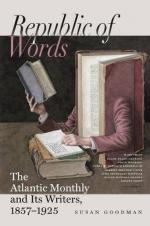As to motion, though of course it is not present in stereoscopic pictures, except in those toy-contrivances which have been lately introduced, yet it is wonderful to see how nearly the effect of motion is produced by the slight difference of light on the water or on the leaves of trees as seen by the two eyes in the double-picture.
And lastly with respect to size, the illusion is on the part of those who suppose that the eye, unaided, ever sees anything but miniatures of objects. Here is a new experiment to convince those who have not reflected on the subject that the stereoscope shows us objects of their natural size.
We had a stereoscopic view taken by Mr. Soule out of our parlor-window, overlooking the town of Cambridge, with the river and the bridge in the foreground. Now, placing this view in the stereoscope, and looking with the left eye at the right stereographic picture, while the right eye looked at the natural landscape, through the window where the view was taken, it was not difficult so to adjust the photographic and real views that one overlapped the other, and then it was shown that the two almost exactly coincided in all their dimensions.
Another point in which the stereograph differs from every other delineation is in the character of its evidence. A simple photographic picture may be tampered with. A lady’s portrait has been known to come out of the finishing-artist’s room ten years younger than when it left the camera. But try to mend a stereograph and you will soon find the difference. Your marks and patches float above the picture and never identify themselves with it. We had occasion to put a little cross on the pavement of a double photograph of Canterbury Cathedral,—copying another stereoscopic picture where it was thus marked. By careful management the two crosses were made perfectly to coincide in the field of vision, but the image seemed suspended above the pavement, and did not absolutely designate any one stone, as it would have done, if it had been a part of the original picture. The impossibility of the stereograph’s perjuring itself is a curious illustration of the law of evidence. “At the mouth of two witnesses, or of three, shall he that is worthy of death be put to death; but at the mouth of one he shall not be put to death.” No woman may be declared youthful on the strength of a single photograph; but if the stereoscopic twins say she is young, let her be so acknowledged in the high court of chancery of the God of Love.
Some two or three years since, we called the attention of the readers of this magazine to the subject of the stereoscope and the stereograph. Some of our expressions may have seemed extravagant, as if heated by the interest which a curious novelty might not unnaturally excite. We have not lost any of the enthusiasm and delight which that article must have betrayed. After looking over perhaps a hundred thousand stereographs and making a collection of about a thousand, we should feel the same excitement on receiving a new lot to look over and select from as in those early days of our experience. To make sure that this early interest has not cooled, let us put on record one or two convictions of the present moment.




